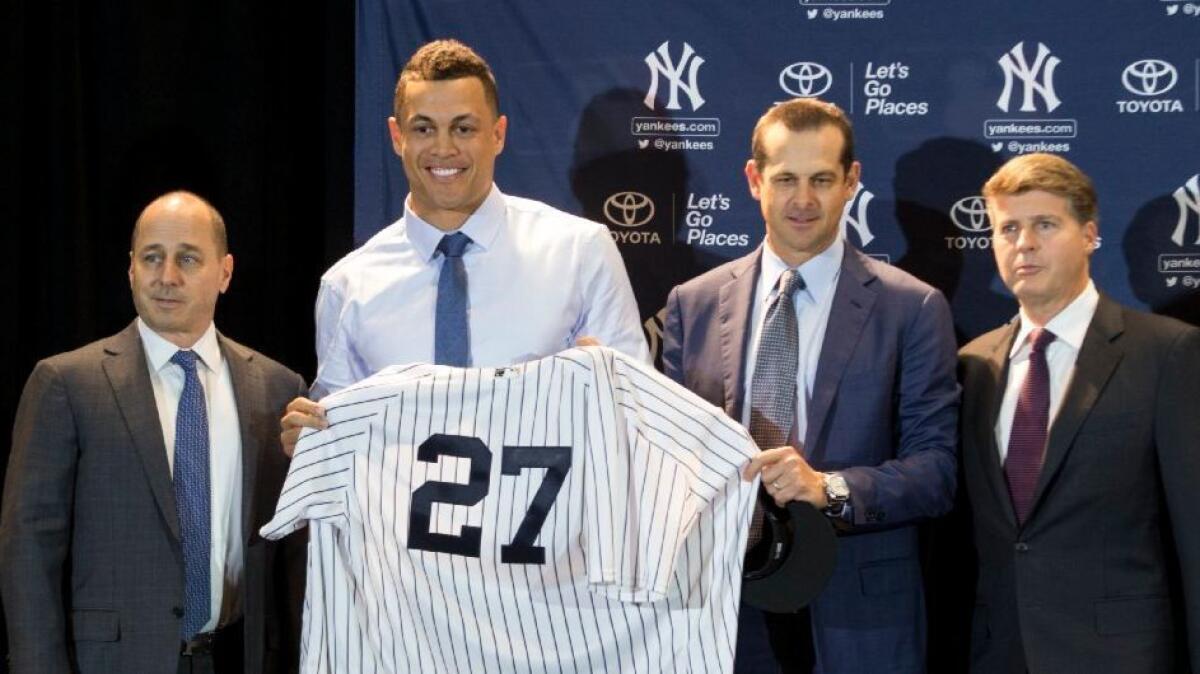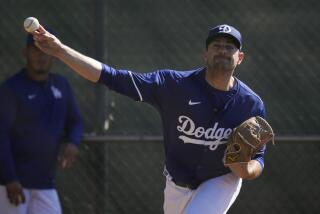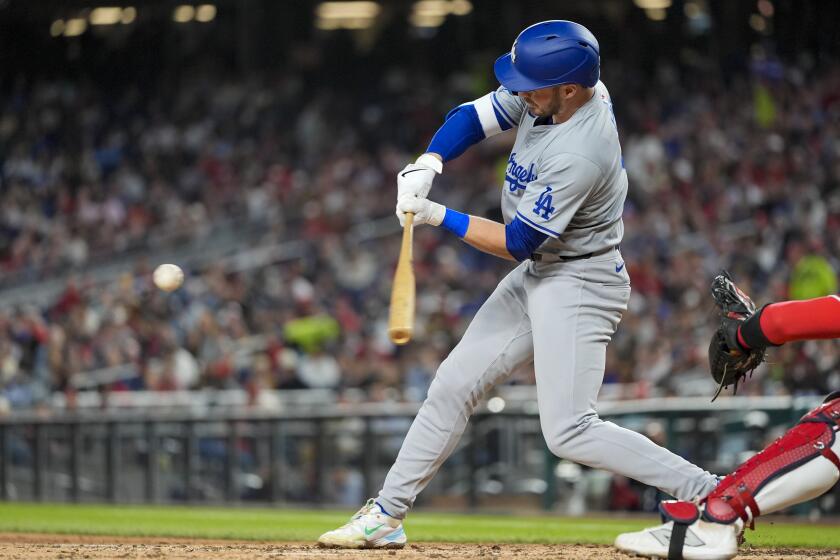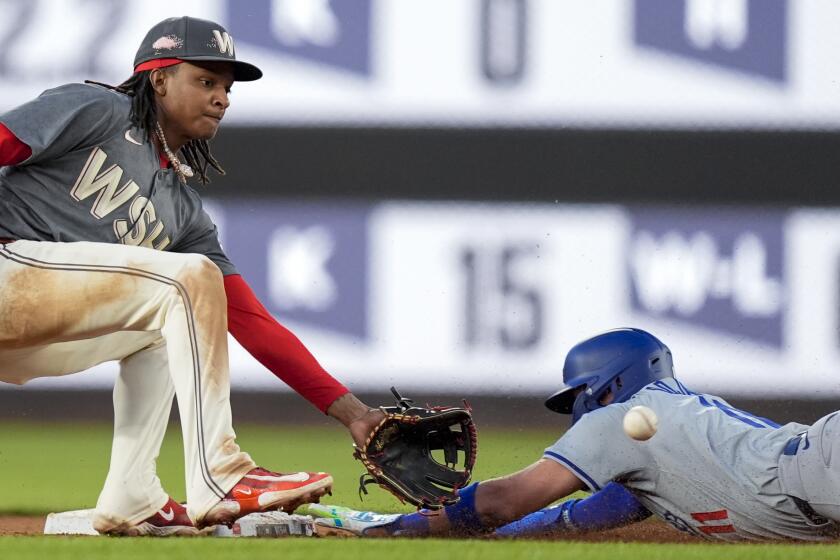As Yankees introduce Giancarlo Stanton, Dodgers prepare for winter of financial restraint

He strode across the stage toward his new manager and grabbed his new jersey. Giancarlo Stanton never hid his desire to be a Dodger, but childhood dreams do not involve the luxury tax. And so Stanton buttoned up the pinstripes of the New York Yankees on the first day of the winter meetings, a representation of the biggest ticket item on the market coming off the board.
“Sometimes, things just spiral out of place,” Stanton said as he stood at a podium at the Walt Disney World Swan and Dolphin Resort, where the meetings are being held. “And you need to find a new home.”
Eager to escape a situation in Miami he described as lacking direction and stability, Stanton jolted the baseball industry with his new destination. The arrival of the reigning National League most valuable player in New York also underscored the financial restrictions facing the Dodgers this winter after five consecutive years exceeding the majors’ luxury-tax threshold. After supporting the game’s largest payroll every season since 2014, the Dodgers may practice this restraint this winter in preparation for next offseason, when Clayton Kershaw could join fellow superstars Bryce Harper, Manny Machado and Josh Donaldson in free agency.
Disinterested in bloating their budget and lacking major holes, the Dodgers have yet to make a substantial move this winter. That pattern could hold through this week and into the spring. Andrew Friedman, the team’s president of baseball operations, identified the bullpen as his club’s most pressing concern. Still, he conceded the team needed to practice “creativity” in order to take on “significant, substantial commitments.”
“There are definitely ways that this winter can play out where we make a few bigger moves,” Friedman said. “But I also think there are scenarios in which this winter plays out where there aren’t moves of substance, and it’s more on the margin.
“Our thought process is we’re really happy with the talent base that we have right now. And so anything that we do that makes it better we’ll obviously be very happy about. We’re not going to try to force anything.”
The strategy represents a shift from last winter, when the Dodgers handed out $192 million to re-sign Justin Turner, Kenley Jansen and Rich Hill. Friedman connected the aggression of that offseason to the calm of this one.
“We consciously did a lot of our heavy lifting last winter, recognizing that we were locking a core in place for the foreseeable future,” Friedman said. “And we were happy about it then. We’re happy about it now.”
The optimism is well-earned. The Dodgers won 104 games last season and reached Game 7 of the World Series. The depth in the starting rotation is impressive and the lineup is mostly set.
Despite the faith in their roster, the team still pondered the feasibility of adding Stanton, who led the majors with 59 home runs in 2017. An attempt at fiscal creativity could not bridge a gap with the Marlins, who were attempting to shed Stanton’s 10-year, $295-million contract.
Stanton held a full no-trade clause. As he bartered with Miami’s new ownership, now led by Derek Jeter, he provided a list of four teams he would accept: the Dodgers, the Yankees, the Houston Astros and the Chicago Cubs. Having never played in the postseason, Stanton prioritized an opportunity with a contender, which was why he selected the four participants in the league Championship Series, explained his agent, Joel Wolfe.
The Marlins attempted to leverage Stanton into changing his mind, and brokered trades with the San Francisco Giants and St. Louis Cardinals. During a meeting last week, Marlins officials told Stanton that if he did not accept a trade to St. Louis or San Francisco “he would be in Miami for the rest of his career,” Wolfe said. Stanton was not intimated. “Look at him,” Wolfe said. “I don’t think he takes anything as a threat.”
The bluff failed. Unable to sway Stanton, the Marlins re-engaged with the teams on Stanton’s list. The Dodgers’ payroll remained an issue. With their luxury-tax payroll number estimated at $205.5 million, above the $197 million threshold that triggers penalties, the Dodgers needed to unload contracts for players like Scott Kazmir, Brandon McCarthy and Adrian Gonzalez to make the trade palatable.
“They were never able to make a deal with the Marlins,” Wolfe said. “So we were never presented with them as a viable option. That’s about all I can say.”
Added Stanton: “I’m not sure how aggressive they were.”
Stanton understood the Dodgers finances. Wolfe joked that Stanton could lecture at a conference after studying the intricacies of the situation. With Kershaw, Kazmir, Gonzalez, McCarthy, Logan Forsythe, Yasmani Grandal and Hyun-Jin Ryu all entering free agency after 2018, the Dodgers will improve their flexibility significantly. Even if Kershaw is likely the highest priority, they can spend elsewhere.
But Stanton did not want to wait. In 2014, he fractured his orbital bone after being hit in the face with a fastball. A lesson stuck with him after the wounds healed. Stanton wanted to maximize the opportunity in front of him, rather than tempt fate again.
“It was a consideration,” Wolfe said. “But he has this attitude that life is fleeting. We don’t know where we’re going to be in a year.”
He will not be a Dodger. He will be a Yankee, for the next decade, as Wolfe insisted Stanton did not intend to opt out of his contract in 2020. The Yankees were reportedly willing to pay $265 million for the privilege of employing him.
The Dodgers were forced to pivot. They could engage Miami about outfielder Marcell Ozuna. They could revisit Pittsburgh’s interest in trading former MVP Andrew McCutchen. Or they could stand pat, address a few minor concerns and head into 2018.
“You look around our team, there are not very many obvious areas to address,” Friedman said. “That being said, of course we’re still going to be opportunistic.”
Twitter: @McCulloughTimes
More to Read
Are you a true-blue fan?
Get our Dodgers Dugout newsletter for insights, news and much more.
You may occasionally receive promotional content from the Los Angeles Times.







